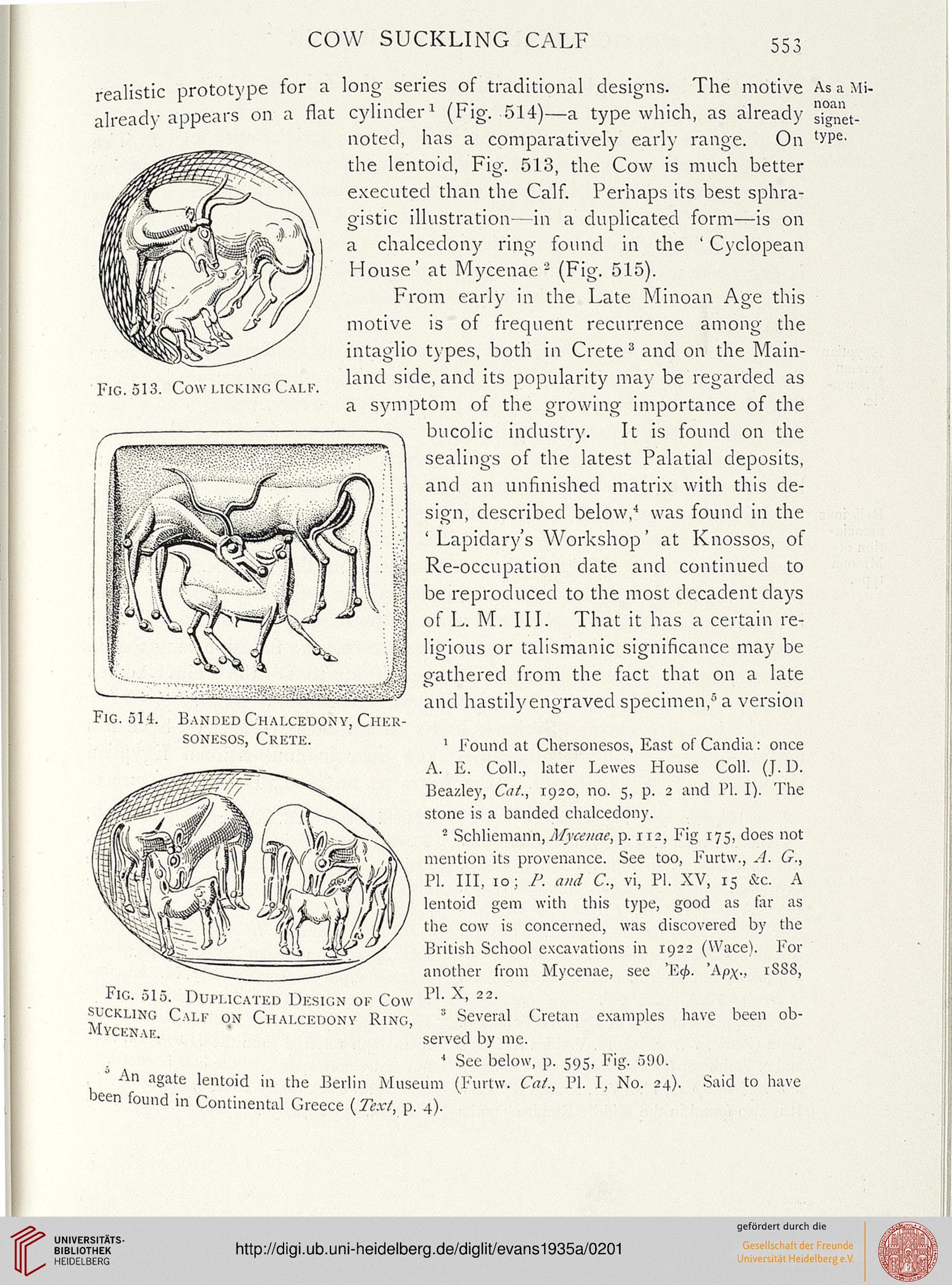COW SUCKLING CALF
553
noan
signet-
On w^
realistic prototype for a long series of traditional designs. The motive AsaMi-
already appears on a flat cylinder1 (Fig. 514)—a type which, as already
noted, has a comparatively early range,
the lentoid, Fig. 513, the Cow is much better
executed than the Calf. Perhaps its best sphra-
gistic illustration—in a duplicated form—is on
a chalcedony ring found in the ' Cyclopean
House' at Mycenae2 (Fig. 515).
From early in the Late Minoan Age this
motive is of frequent recurrence among the
intaglio types, both in Crete 3 and on the Main-
land side, and its popularity may be regarded as
a symptom of the growing importance of the
bucolic industry. It is found on the
(j ."' ■'■'""7 seahngs of the latest Palatial deposits,
i: *" '*'"*" and an unfinished matrix with this de-
sign, described below,4 was found in the
' Lapidary's Workshop' at Knossos, of
Re-occupation date and continued to
be reproduced to the most decadent clays
of L. M. III. That it has a certain re-
ligious or talismanic significance may be
o-athered from the fact that on a late
and hastily engraved specimen,6 a version
Cow.
jtg Cai
1 Found at Chersonesos, East ofCandia: once
A. E. Coll., later Lewes House Coll. (J.D.
Beazley, Cat., 1920, no. 5, p. 2 and PI. 1). The
stone is a banded chalcedony.
2 Sclilieman'n, Mycenae, p. 112, Fig 175, does not
mention its provenance. See too, Furtw., A. G.,
PL III, 10; P. and C, vi, PI. XV, 15 &c. A
lentoid gem with this type, good as far as
the cow is concerned, was discovered by the
British School excavations in 1922 (VVace), For
another from Mycenae, see 'Bc/>. 'Apx-, iSSS,
PI. X, 22.
s Several Cretan examples have been ob-
served by me.
■' See below, p. 595, Fig. 590.
"in agate lentoid in the Berlin Museum (Furtw. Cat., PI. I, No. 24). Said to have
Fig. 515. Dd
suckling Calf
Mycenae.
licated Design of Cow
on Chalcedony Ring,
been found in Continental Greece {Text, p. 4).
553
noan
signet-
On w^
realistic prototype for a long series of traditional designs. The motive AsaMi-
already appears on a flat cylinder1 (Fig. 514)—a type which, as already
noted, has a comparatively early range,
the lentoid, Fig. 513, the Cow is much better
executed than the Calf. Perhaps its best sphra-
gistic illustration—in a duplicated form—is on
a chalcedony ring found in the ' Cyclopean
House' at Mycenae2 (Fig. 515).
From early in the Late Minoan Age this
motive is of frequent recurrence among the
intaglio types, both in Crete 3 and on the Main-
land side, and its popularity may be regarded as
a symptom of the growing importance of the
bucolic industry. It is found on the
(j ."' ■'■'""7 seahngs of the latest Palatial deposits,
i: *" '*'"*" and an unfinished matrix with this de-
sign, described below,4 was found in the
' Lapidary's Workshop' at Knossos, of
Re-occupation date and continued to
be reproduced to the most decadent clays
of L. M. III. That it has a certain re-
ligious or talismanic significance may be
o-athered from the fact that on a late
and hastily engraved specimen,6 a version
Cow.
jtg Cai
1 Found at Chersonesos, East ofCandia: once
A. E. Coll., later Lewes House Coll. (J.D.
Beazley, Cat., 1920, no. 5, p. 2 and PI. 1). The
stone is a banded chalcedony.
2 Sclilieman'n, Mycenae, p. 112, Fig 175, does not
mention its provenance. See too, Furtw., A. G.,
PL III, 10; P. and C, vi, PI. XV, 15 &c. A
lentoid gem with this type, good as far as
the cow is concerned, was discovered by the
British School excavations in 1922 (VVace), For
another from Mycenae, see 'Bc/>. 'Apx-, iSSS,
PI. X, 22.
s Several Cretan examples have been ob-
served by me.
■' See below, p. 595, Fig. 590.
"in agate lentoid in the Berlin Museum (Furtw. Cat., PI. I, No. 24). Said to have
Fig. 515. Dd
suckling Calf
Mycenae.
licated Design of Cow
on Chalcedony Ring,
been found in Continental Greece {Text, p. 4).





